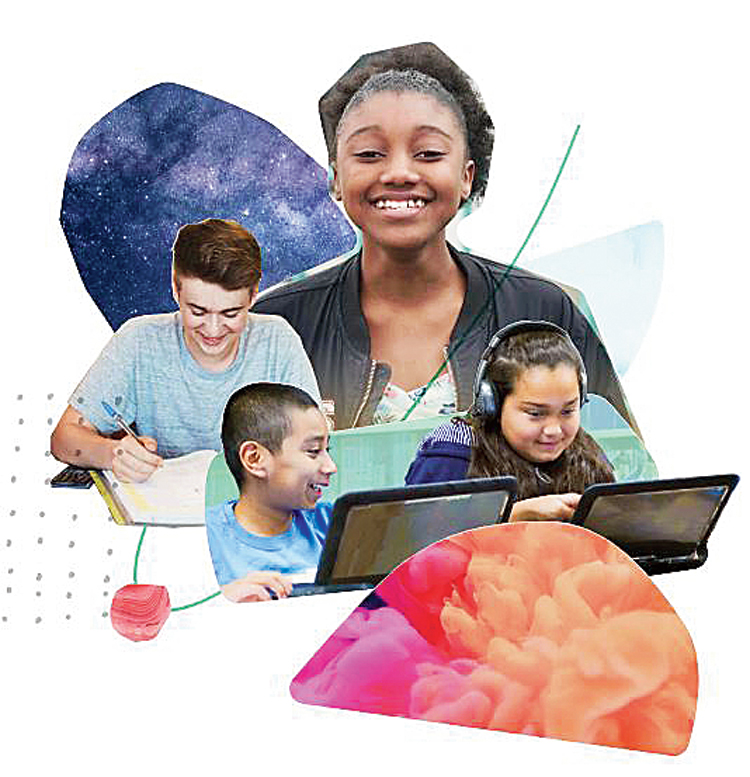1. Free online learning
There are quite a few free online learning options that introduce parents and students to what can be achieved in the digital era. Two options that are good for young learners are SchoolTube and Khan Academy. One can think of the former as a YouTube for students, giving them video nuggets around STEM-related topics, reading and writing. An example: In “edit your writing” a passage is shown (like “Do you likes dogs? You kan get a dog from a pet.”), followed by how the mistakes in the copy need to be tackled. On the other end of the spectrum is Khan Academy, which is an online learning resource for kids, offering practice exercises, instructional videos, and “a personalised learning dashboard”. The website tackles math, science, computer programming, history, art history, economics and more.
2. Rockstar start-ups
Closer home is BYJU’S, founded by Byju Raveendran. The educational technology and online tutoring firm is today one of India’s most valuable start-ups and is the first company in Asia to receive an investment from Chan-Zuckerberg Initiative
(co-funded by Facebook founder Mark Zuckerberg and Priscilla Chan) and has as brand ambassador, Shah Rukh Khan. There is something or the other for students between Class I and XII, from learning easy concepts to in-depth study material. The last time we met Raveendran, he was surrounded by youngsters. Of course, he had a wonderful story to tell. “I started my journey from a small village called Azhikode in the Kannur district of Kerala. Contrary to what most people think of as a disadvantage, being from a small place has been a great boon for me as I landed up learning everything and anything on my own. For example, I studied in a Malayalam-medium school but learnt English by listening to cricket commentary and playing games helped me strategise and learn on my own,” he told The Telegraph.
Another option is WhiteHat Jr, founded by Karen Bajaj, the former Discovery Networks CEO. The Mumbai-based start-up focuses on youngsters wanting to take up coding. Founded in 2018, the start-up has found takers across the country. “Over the past few months, WhiteHat Jr’s online platform has seen over 150,000 student trials, over 400,000 student projects created, over 500 teachers onboarded and 100 per cent month-on-month student and revenue growth,” Bajaj recently told The Telegraph. From teaching simple ways to create animation to puzzle solving to data visualisation and basics of neural learning, the start-up covers a lot.
“I believe in the incredible power of early childhood learning and wanted to harness the creativity that most five- or six-year-olds naturally have. After reading a fair bit of research on the subject from MIT I found that kids use the fundamentals of logic, sequence, structure and algorithmic thinking while coding to create tech products, for example, games, animations and apps. More fundamentally, at an early age they start viewing themselves as creators-makers of games versus players of games, creators of videos versus surfers of videos.”
3. Enter Minecraft and Prodigy
Minecraft, a cross between Lego and a fantasy adventure, remains one of the most amazing video games, allowing groups of eight players to meet online and construct buildings and much more. There is a private option that allows kids to play only with people they know. All you need to keep an eye on is the time spent in the virtual world.
Equally engaging is Prodigy, a math-based game. The kid enters a magical world where he or she first selects where the game is being played — from home or school. If it’s from home, the digital avatar attends a digital school. Soon the user can cast spells on monsters by solving simple maths. Addictive.
4. Lego Day(s)
There are small Lego sets hiding here and there in the house. Find them. Put it to good use. Since school will be out for a few weeks, we suggest you get the classic creative block from Lego, which comes with hundreds of pieces that can be put together to form thousands of objects. Something even more enticing? Lego WeDo. It’s costly but it’s a great way to introduce kids to robotics and, at the same time, take the school curriculum forward (yes, at several schools in India WeDo is a popular option). In case you haven’t had a chance to go the WeDo way, it’s a STEAM-based learning tool that combines physical Lego bricks and simple block-based coding to come with some amazing projects that would help develop problem-solving skills.
5. Go Scholastic
Scholastic has launched a ‘Learn at Home’ website with daily courses for students in pre-kindergarten to grades six and higher. This is completely new and the way the educational company has come up with the website so quickly makes us admire the power of technology. What did we learn in the last couple of days? We read about eight-year-old Jordan Reeves whose disability doesn’t stop her from learning how to dance. We learned how 3D printers works… in easy language. Guess why zebras have stripes or how kids go to school around the world? Agreed, the content on the website is US-focussed but that doesn’t make the material less interesting.
6. Subscription boxes
It’s super fun, doesn’t cost the earth and kids learn something new all the time. Subscription boxes contain projects that kids receive (a similar model has been employed in other categories — lifestyle and food — for adults) every month. One can ask for a box containing projects for a month, couple of months, six months or even a year. We suggest you start with one box and then decide. Most of the projects help children develop motor, cognitive and social skills.
Two popular options are Flintobox and Magic Crate. Using a Flintobox one learns things like building a catapult and sand drawing. Each month the box arrives with a number of projects, so children can do, say, one a week. “In 2013, Vijay (Vijay Babu Gandhi, one of the co-founders) came to us with a problem that his five-year-old son was spending a disproportionate amount of time in front of screens. Vijay found it very difficult to deviate his son from gadgets and keep him meaningfully engaged as he was juggling between a busy schedule and prioritising his son’s developmental needs. With nuclear families increasing in number, where both the parents go out to work, there’s hardly any time for parents to engage kids meaningfully at home. Vijay bounced off an idea: If there was someone who could professionally curate toys, activities, and books, it would be a huge benefit for parents and could cause a lasting impact on a child’s life,” Arunprasad Durairaj, CEO and co-founder of Flinto Learning Solutions, has told The Telegraph.
Similarly, Magic Crate too has some great ideas. For example, if you order a box from this service for a kid who is in the six-to-eight age group, one would receive something like the ‘Little Astronaut’ box, containing augmented reality-enabled, play-based activities and a storybook. Box options include Little Mariner, Little Detective and much more.
Another option? XploraBox. On its website, the upcoming boxes are clearly mentioned, like in April it’s ‘Simple Machines’, followed by Time Traveller, Space Traveller and ‘Multiplications and Logic’.











